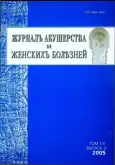The negative experience of somatostatin synthetic analogist using in therapy of policystoc ovaries
- Authors: Grinvald D.V.1, Kirsanov А.A.1, Kasumova А.R.1, Bondarenko М.V.1
-
Affiliations:
- Research Institute of Obstetrics, Gynecology and Reproductology named after D.O. Ott
- Issue: Vol 54, No 2 (2005)
- Pages: 40-43
- Section: Original study articles
- URL: https://bakhtiniada.ru/jowd/article/view/81809
- DOI: https://doi.org/10.17816/JOWD81809
- ID: 81809
Cite item
Full Text
Abstract
The blood content of insulin—like growth factor—1 (IGF—1) in woman with ovarian hyperstimulation syndrome (OHSS) is low that may be connect with damage of synthetic function of liver. The use of synthetic analogist of somatostatin in treatment of OHSS don’t lead to reliable positive results. Low content of IGF—1 in OHSS makes pathogeneticaly non—justifight the treatment of OHSS by synthetic analogist of somatostatin.
Full Text
##article.viewOnOriginalSite##About the authors
D. V. Grinvald
Research Institute of Obstetrics, Gynecology and Reproductology named after D.O. Ott
Author for correspondence.
Email: info@eco-vector.com
Russian Federation, Saint Petersburg
А. A. Kirsanov
Research Institute of Obstetrics, Gynecology and Reproductology named after D.O. Ott
Email: info@eco-vector.com
Russian Federation, Saint Petersburg
А. R. Kasumova
Research Institute of Obstetrics, Gynecology and Reproductology named after D.O. Ott
Email: info@eco-vector.com
Russian Federation, Saint Petersburg
М. V. Bondarenko
Research Institute of Obstetrics, Gynecology and Reproductology named after D.O. Ott
Email: info@eco-vector.com
Russian Federation, Saint Petersburg
References
Supplementary files






